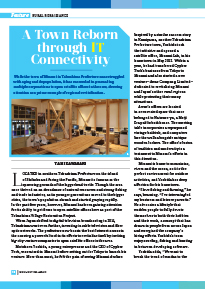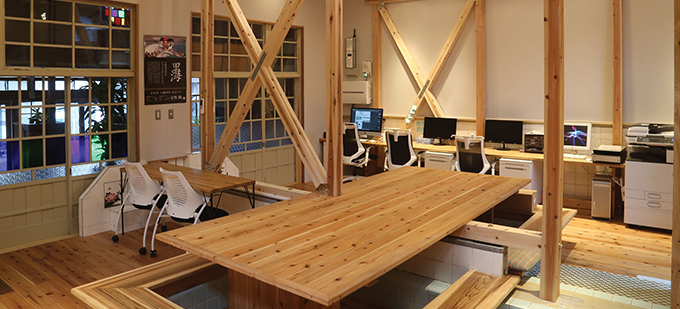Home > Highlighting JAPAN >Highlighting Japan June 2015>Rural Renaissance
Highlighting JAPAN

Rural Renaissance
A Town Reborn through IT Connectivity
While the town of Minami in Tokushima Prefecture once struggled with aging and depopulation, it has succeeded in persuading multiple corporations to open satellite offices in the area, drawing attention as a prime example of regional revitalization.

Located in southern Tokushima Prefecture on the island of Shikoku and facing the Pacific, Minami is famous as the spawning grounds of the loggerhead turtle. Though the area once thrived on an abundance of natural resources and strong fishing and trade industries, as its younger generations moved to the bigger cities, the town’s population shrank and started graying rapidly. In the past few years, however, Minami has been gaining attention for its ability to get firms to open satellite offices here as part of the Tokushima Village Restoration Project.
When Japan shifted to digital television broadcasting in 2011, Tokushima went even further, investing in cable television and fiber optic networks. The prefecture now boasts the best Internet access in the country, a powerful tool in its efforts to revitalize itself by inviting big-city venture companies to open satellite offices in the area.
Motoharu Yoshida, a young entrepreneur and the CEO of Cypher Tech, was raised in Minami before setting out for Tokyo to launch his venture. More than most, he felt the pain of seeing Minami decline. Inspired by a similar success story in Kamiyama, another Tokushima Prefecture town, Yoshida took the initiative and opened a satellite office, Minami Lab, in his hometown in May 2012. Within a year, he had transferred Cypher Tech’s business from Tokyo to Minami and also started a new venture—Awae Company, Limited—dedicated to revitalizing Minami and Japan’s other rural regions while protecting their many attractions.
Awae’s offices are located in a renovated space that once belonged to Hatsune-yu, a Meiji Era public bathhouse. The meeting table incorporates a repurposed vintage bathtub, and computers line the walls alongside antique wooden lockers. The office’s fusion of tradition and modernity is a testament to Minami’s efforts in this direction.
Minami is home to mountains, rivers and the ocean, so it is the perfect environment for outdoor activities, and Yoshida has deep affection for his hometown.
“I love fishing and farming,” he says, beaming. “I’ve intermingled my business and leisure pursuits.” He advocates a lifestyle that enables people to fully devote themselves to both their hobbies and their work, a concept that has drawn in people from across Japan and energized the company’s hiring efforts. Yoshida’s team enjoys surfing, fishing and hunting in between developing software.
Yoshida adds, “We want to break the trend of exodus to the capital in pursuit of work.” His vision and Minami’s own active courting of such businesses has borne fruit: nine firms have now opened satellite offices in town. For the first time in thirty-five years, Minami is enjoying an influx of people moving to the area and a net gain in its working-age population.
Suzuki Shouten, an Osaka technology startup, launched its satellite office—which they call Mikumoya—here in September 2013. Takeyoshi Kobayashi, who works at Mikumoya, says he brought his mother with him when he moved to Minami.
“It’s nothing like the big city, where you’re constantly hounded by work without a chance to rest,” says Kobayashi, an energetic young man who loves fishing and surfing. “Life in Minami lets you make use of each day to the fullest, pursuing both a vocation and avocation. Productivity is actually higher here.” After finishing our interview, Kobayashi was seen helping some fishermen behind the office fold a casting net. True to his words, he appears to be living a fulfilling life.
Minami’s community warmly welcomes new residents, encouraging them to take part in village festivals and gatherings at the assembly hall, join in fishing and go surfing. The town also presents them with freshly caught abalone on their birthdays, and occasionally new arrivals even receive hand-me-downs of old boats.
“The lingua franca here is fun,” says Yoshida. “Hobbies and festivals let you become a part of the local community.” Minami is also home to Yakuoji, the twenty-third stop on Shikoku’s famed 88-shrine pilgrimage, granting it a spirit long accustomed to welcoming visitors.
“Overconcentration in cities and aging populations in the provinces are not problems unique to Japan,” says Cypher Tech’s Yoshida, who is exploring ways to use information technology to assist local economies, such as turning hidden rural traditions into commercial products. He wants to find new business models that can take root in rural areas.
Meanwhile, Mikumoya is actively recruiting local high school graduates, seeking to hire enthusiastic graduates from within the prefecture as the next generation of talent. As new residents work to give back to their newfound home, collaborations are taking shape that will allow the entire area to thrive.
© 2009 Cabinet Office, Government of Japan






